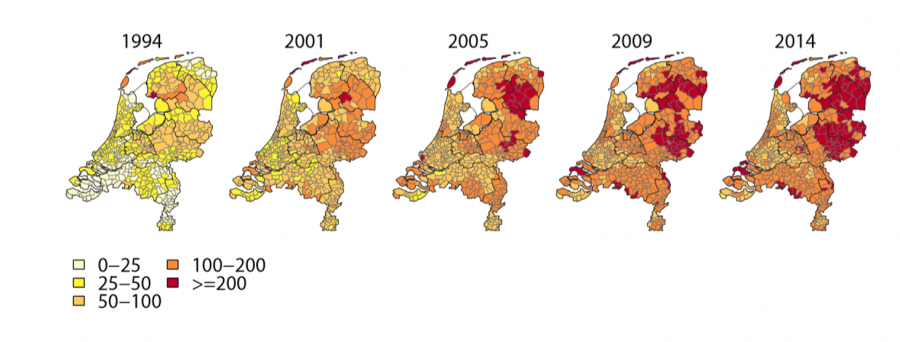Simulating Tick Bites using Agent-Based Modelling
 Number of diagnosed Lyme cases per 100,000 inhabitatnts for the Netherlands 1994-2014
Number of diagnosed Lyme cases per 100,000 inhabitatnts for the Netherlands 1994-2014Objective:
Keywords:
 Worldwide geographical distribution of reported Lyme Disease cases (wikipedia)
Worldwide geographical distribution of reported Lyme Disease cases (wikipedia)Description:
Lyme disease is the most common vector-borne disease in Northern Hemisphere. It is transmitted by ticks, which are small spiders that live in humid deciduous forests. Ticks are bloodsucking animals that usually feed from mammal hosts, such as rodents or deer, but they can also feed from humans, by attaching themselves to the skin and getting a blood meal that can last for hours. When ticks are removed within a few hours after the tick bite, chances of being infected by Lyme are small. However, when ticks remain unnoticed, the Lyme and other diseases can be transmitted to humans. Lyme disease is estimated to affect several hundred thousand people yearly in both the United States and Europe with its subsequent social and economic cost for people and public health systems. Only in the Netherlands, there are around 25.000 cases of Lyme disease per year and this number has tripled since mid-90s.
Scientists have established some links between the increase of Lyme disease cases and global changes. The global rise of temperature and the profound modifications that human societies cause in our landscape (e.g. deforestation, urbanization, construction) have shifted the tick habitat northwards and triggered a growth in the tick populations, thus increasing the chances for humans to get this infection.
This MSc research topic is part of ongoing research on the spatio-temporal analysis of ticks, tick bites and Lyme disease using Volunteered Geographic Information (VGI) data from Tekenradar (https://www.tekenradar.nl/). This research is conducted by ITC in collaboration with the Dutch national public health institute (RIVM) and Wageningen University. After detecting a tick bite, ticks can be removed and the bite can be registered via in the Tekenradar website where the date and location of the bite can be reported. This registration is on a voluntary basis. Ticks can also be mailed to RIVM for further analysis to determine if the tick carried the bacteria that causes Lyme. Not all tick bites are registered via the Tekenradar website. However, we know that press and media releases (promotional campaigns) leads to an increase in the number of registered tick bites.
The risk of getting a tick bite depends on two interrelated phenomena: tick densities in natural spaces and human exposure. Tick densities varies based on the vegetation (ticks prefer shrubs and high grasses), temperature and other weather factors. The risk of getting a tick bite also depends on the exposure. Tourists are “easy victims” as they often go outdoors, visit nature parks and might conduct activities like hiking, camping, berry hunting and picnicking.
Here we propose to develop an agent-based simulation model using Netlogo that will include the already developed tick habitat and activity models. The simulation model should include a human/tourist activity sub-model and a tick bite registration sub-model. Comparison of the output of this agent-based model with the Tekenradar actual data will allow for model calibration.
References:
Estrada-Peña, A., de la Fuente, J., Latapia, T., & Ortega, C. (2015). The Impact of Climate Trends on a Tick Affecting Public Health: A Retrospective Modeling Approach for Hyalomma marginatum (Ixodidae). PloS One, 10(5), e0125760. doi:10.1371/journal.pone.0125760
Garcia-Martí, I., Zurita-Milla, R., Swart, A., van den Wijngaard, C. C., van Vliet, A. J. H., Bennema, S., & Harms, M. (2016). Identifying environmental and human factors associated with tick bites using volunteered reports and frequent pattern mining. Transactions in GIS (In press).
Medlock, J. M., Hansford, K. M., Bormane, A., Derdakova, M., Estrada-Peña, A., George, J.-C., … Van Bortel, W. (2013). Driving forces for changes in geographical distribution of Ixodes ricinus ticks in Europe. Parasites & Vectors, 6, 1. doi:10.1186/1756-3305-6-1
Ostfeld, R. S. (1997). The Ecology of Lyme-Disease Risk disease Diagnosing the Disease Natural History of Lyme Disease Life Cycle of the Tick.
Sprong, H., Hofhuis, A., Gassner, F., Takken, W., Jacobs, F., van Vliet, A. J. H., … Takumi, K. (2012). Circumstantial evidence for an increase in the total number and activity of Borrelia-infected Ixodes ricinus in the Netherlands. Parasites & Vectors, 5(1), 294. doi:10.1186/1756-3305-5-294

